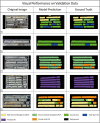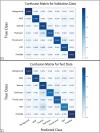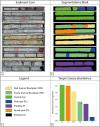Sediment core analysis using artificial intelligence
- PMID: 37989779
- PMCID: PMC10663584
- DOI: 10.1038/s41598-023-47546-2
Sediment core analysis using artificial intelligence
Abstract
Subsurface stratigraphic modeling is crucial for a variety of environmental, societal, and economic challenges. However, the need for specific sedimentological skills in sediment core analysis may constitute a limitation. Methods based on Machine Learning and Deep Learning can play a central role in automatizing this time-consuming procedure. In this work, using a robust dataset of high-resolution digital images from continuous sediment cores of Holocene age that reflect a wide spectrum of continental to shallow-marine depositional environments, we outline a novel deep-learning-based approach to perform automatic semantic segmentation directly on core images, leveraging the power of convolutional neural networks. To optimize the interpretation process and maximize scientific value, we use six sedimentary facies associations as target classes in lieu of ineffective classification methods based uniquely on lithology. We propose an automated model that can rapidly characterize sediment cores, allowing immediate guidance for stratigraphic correlation and subsurface reconstructions.
© 2023. The Author(s).
Conflict of interest statement
The authors declare no competing interests.
Figures





References
-
- Martinson DG, et al. Age dating and the orbital theory of the ice ages: Development of a high-resolution 0 to 300,000-year chronostratigraphy. Quat. Res. 1987;27:1–29. doi: 10.1016/0033-5894(87)90046-9. - DOI
-
- Mayewski PA, et al. Holocene climate variability. Quat. Res. 2004;62:243–255. doi: 10.1016/j.yqres.2004.07.001. - DOI
-
- Mitchum RM, Jr, Vail PR, Thompson SI. Seismic stratigraphy and global changes of sea level, part 2: The depositional sequence as a basic unit for stratigraphic analysis. In: Payton CE, editor. Seismic Stratigraphy—Applications to Hydrocarbon Exploration. American Association of Petroleum Geologists; 1977.
-
- Posamentier HW, Jervey MT, Vail PR, et al. Eustatic controls on clastic deposition I—conceptual framework. In: Wilgus CK, et al., editors. Sea-Level Changes: An Integrated Approach. SEPM Special Publication; 1988.
-
- Neal J, Abreu V. Sequence stratigraphy hierarchy and the accommodation succession method. Geology. 2009;37:779–782. doi: 10.1130/G25722A.1. - DOI
Grants and funding
LinkOut - more resources
Full Text Sources

